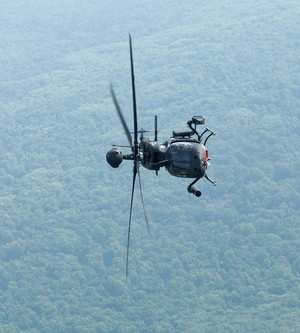Upgrades Will Extend Aircraft Service Life Through 2025
The U.S. Army is beginning mission equipment upgrade
modifications to its fleet of OH-58 Kiowa Warrior scout aircraft in
an effort to build a new, high-tech "F" model helicopter designed
with improved avionics, better sensors and stepped-up overall
performance capability, service officials said. The first "F" model
flight is slated for next year, said Lt. Col. Scott Rauer, product
manager, Kiowa Warrior. Overall, the Army plans to acquire 368 "F"
model OH-58s, an aircraft which comes to life through a series of
technical upgrades and changes to the current "D" model Kiowa.

94 Kiowa Warrior scout helicopters perform a range of crucial
missions in Iraq and Afghanistan to include light attack missions,
general reconnaissance, IED detection and convoy escort missions,
Rauer said. "It's the highest demand rotary-wing aircraft in Army
aviation. It flies more than 90 hours a month -- about seven times
the normal usage rate," he added.
The "F" model Kiowa upgrade - which will ensure the aircraft's
service life through 2025 - includes a host of technical upgrades
being performed by an Army government design house at Redstone
Arsenal, AL, and a handful of its industry partners to include Bell
Helicopter, Honeywell and Rolls Royce. The thrust of the
improvements center around a Cockpit and Sensor Upgrade Program, or
CASUP, which improves the sensors and moves them to the nose of the
aircraft, Rauer explained.
The new sensor, called the AAS-53 Common Sensor Payload,
includes cutting-edge sensing technologies such as an advanced
infrared camera, a color Electro-Optical camera and an image
intensifier similar to what is used by Night Vision goggles, Rauer
said. The sensors are engineered to work together with laser
designators and image trackers to pinpoint targets on the
battlefield. "This is a major leap ahead in situational awareness
for the crew. The Common Sensor Payload does bring fusion
technology where it can merge imagery. With this sensor, you can
fuse imagery together to get the best picture," Rauer said.
Moving the sensor to the nose, which involves removing the
mast-mounted sight, which currently stands on top of the "D" model
Kiowa, requires the transmission mounting structures to be
redesigned, Rauer explained. "You've got to be able to pass the
rotor vibrations cleanly to the rest of the aircraft," he said. The
"F" model Kiowa will be outfitted with next-generation cockpit
technologies called Control and Display Subsystem, version 5, Rauer
said. "This brings advanced processing power, more memory and
throughput, full color graphics, and dual-independent advanced
moving maps," Rauer explained.

File Photo
The improved cockpit avionics - made by Honeywell - include an
increased capacity to store and process key digital information.
The "F" model cockpit will include a Force Battle Command Brigade
and Below, or FBCB2 display screen. Later versions of the "F" model
aircraft will include a faster, more high-tech Blue Force Tracker 2
for improved battle situational awareness.
The aircraft will also be built with a dual-channel
full-authority digital engine-controller built by Rolls Royce, to
ensure the engine operates at its required power level regardless
of the environment and the various demands placed on the aircraft,
Rauer said. The OH-58 is configured with what is called Level 2
Manned-Unmanned teaming, or L2MUM - which means that the pilots in
the cockpit can view feeds from nearby unmanned aircraft systems in
real time. In terms of protection, the Kiowa Warrior is configured
with protective ballistic floor armor and the Common Missile
Warning System, or CMWS, which can shoot off flares to divert
incoming missiles, Rauer said.
 Bolen Gives Congress a Rare Thumbs-Up
Bolen Gives Congress a Rare Thumbs-Up The SportPlane Resource Guide RETURNS!!!!
The SportPlane Resource Guide RETURNS!!!! Buying Sprees Continue: Textron eAviation Takes On Amazilia Aerospace
Buying Sprees Continue: Textron eAviation Takes On Amazilia Aerospace Hawker 4000 Bizjets Gain Nav System, Data Link STC
Hawker 4000 Bizjets Gain Nav System, Data Link STC Echodyne Gets BVLOS Waiver for AiRanger Aircraft
Echodyne Gets BVLOS Waiver for AiRanger Aircraft




